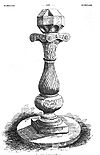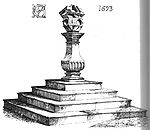
Scottish sundial
Encyclopedia


Renaissance
The Renaissance was a cultural movement that spanned roughly the 14th to the 17th century, beginning in Italy in the Late Middle Ages and later spreading to the rest of Europe. The term is also used more loosely to refer to the historical era, but since the changes of the Renaissance were not...
period are not just more numerous than in any other country, they are also stylistically unique. This is particularly notable when the size and wealth of Scotland
Scotland
Scotland is a country that is part of the United Kingdom. Occupying the northern third of the island of Great Britain, it shares a border with England to the south and is bounded by the North Sea to the east, the Atlantic Ocean to the north and west, and the North Channel and Irish Sea to the...
at the time are taken into account. They are free standing stone sculptures of the 17th and 18th centuries with many small dials inscribed on them. Accurate timetelling is clearly not the aim. Precision is sacrificed for decorative effective. Unlike the sundial
Sundial
A sundial is a device that measures time by the position of the Sun. In common designs such as the horizontal sundial, the sun casts a shadow from its style onto a surface marked with lines indicating the hours of the day. The style is the time-telling edge of the gnomon, often a thin rod or a...
s of similar date on the continent where baroque
Baroque
The Baroque is a period and the style that used exaggerated motion and clear, easily interpreted detail to produce drama, tension, exuberance, and grandeur in sculpture, painting, literature, dance, and music...
decoration may be added, the mathematical complexity of the Scottish dials is decoration enough. The ancient sundials of Scotland can be grouped into three main styles: lectern, obelisk and facet-head.
Lectern dials
These are noticeable for their sloping top like a reading desk or lectern, in the equatorial plane, usually with a star on top having dials in all its angles, and at 90 degrees to this a hemi-cylinder with a polar dial inscribed in it. The lectern usually has hollow dials on the south, east and west faces, and hour lines are inscribed in every available angle.One of the more complicated was formerly at Mid Calder House and is now at Culzean Castle
Culzean Castle
Culzean Castle is a castle near Maybole, Carrick, on the Ayrshire coast of Scotland. It is the former home of the Marquess of Ailsa but is now owned by the National Trust for Scotland...
.
Lectern dials have some counterparts in continental Europe. This is particularly true of the Netherlands
Netherlands
The Netherlands is a constituent country of the Kingdom of the Netherlands, located mainly in North-West Europe and with several islands in the Caribbean. Mainland Netherlands borders the North Sea to the north and west, Belgium to the south, and Germany to the east, and shares maritime borders...
which was Scotland's primary trading partner of the time and where several lectern dials survive.
Obelisk dials
Obelisk dials are unique to Scotland and there are only 25 of them known.The first is meant to be that at Drummond Castle
Drummond Castle
Drummond Castle is located in Perthshire, Scotland. The castle is best known for its gardens, described by Historic Scotland as "the best example of formal terraced gardens in Scotland." It is situated in Muthill parish, south of Crieff. The castle comprises a tower house built in the late 15th...
. It was carved in 1630 by John Mylne
John Mylne (d.1657)
John Mylne of Perth was a Scottish master mason who served as Master Mason to the Crown of Scotland. He was born in Perth, the son of John Mylne, also a master mason, and Helen Kenneries....
the King's Master Mason.
Obelisk dials are made up of three parts. The base element is a square shaft with four or five square panels on each side. In these panels are often sunken dials of bowl-hollows, hearts or triangular and rectangular shapes. The middle element is an octangonal section boss. The corners may be cut away and have dials inscribed in the hollows. The crowning element is a square tapering finial which when viewed with the lower square shaft produces the obelisk appearance. This finial also has panelled sides with up to seven or eight on each side. There can be 70 or 80 surfaces in total available for dials.
Facet-head dials
This term includes a wide variety of other types ranging from a simple cube to complex polyhedrals. The most dramatic of these is at Glamis CastleGlamis Castle
Glamis Castle is situated beside the village of Glamis in Angus, Scotland. It is the home of the Earl and Countess of Strathmore and Kinghorne, and is open to the public....
.

